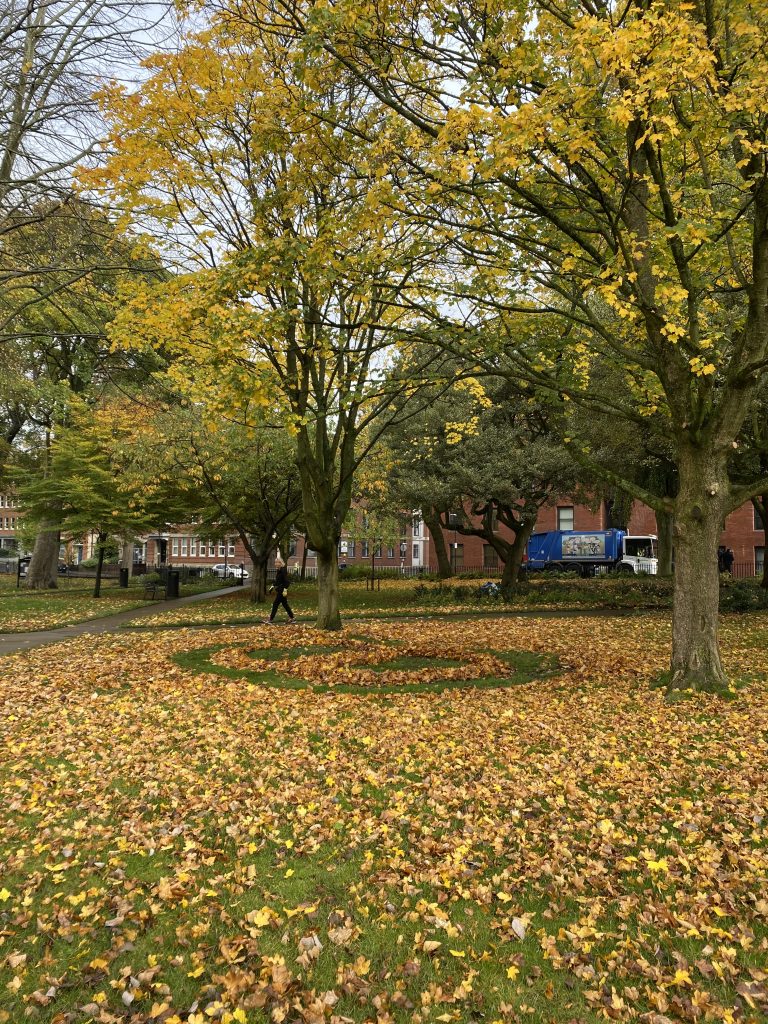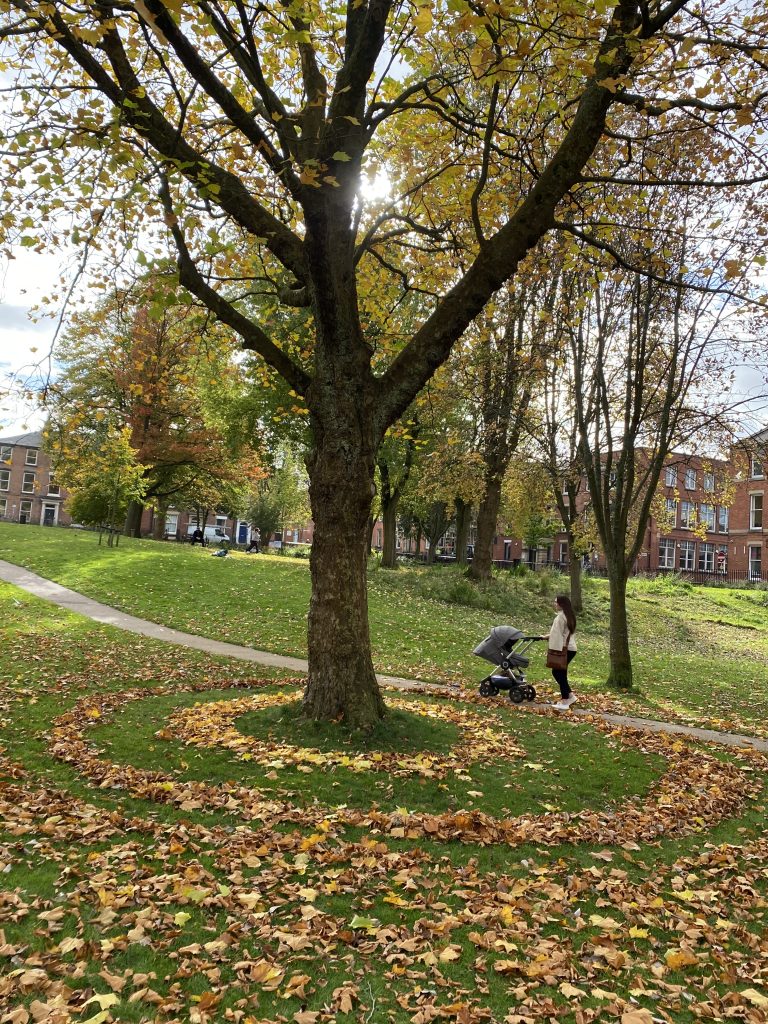Preston based artist Fiona Candy, talks about how she has been progressing her creative practice and staying positive during this difficult time. Fiona has been a designer in the textile and fashion industry, a lecturer in art and design, including many years at UCLan teaching on a range of Design degree courses, and undertaking research in the context of health and wellbeing. She is now a full time, independent artist.
She describes her creative practice as engaging with perception: sight and also touch, hearing, memory, sense of time, movement. When mind, body and world interact. Through her work she has learnt about the growing understanding throughout the world that sustainability depends on an attitude of respect and responsibility towards the Earth. Fiona has recently organised and led an informal, participatory arts project in Winckley Square Gardens, to celebrate the changing season.

Where did you draw the inspiration from for Circling the Square?
Textile is one of the world’s most ancient and ubiquitous crafts. It’s been fundamentally influential in the development of the world’s cultures and trading systems. Through my work as a designer, I learnt about its rich content of symbolism. Today, there is a tendency to view textiles as ‘mere’ pattern, adornment or decoration: a rather superficial and fanciful medium, connected to the imagination and so not to be trusted or taken seriously. Yet this attitude belies the deep, communication of symbols, colours and tactility that can convey depths of meaning beyond words or spoken language. Symbols open up less conscious levels of human experience that cannot be accessed any other way.
Circles can be found everywhere in our lives, from the cheerful, dancing polka dot, to the immediate commands of street signage, the generosity of the dinner plate, or the spiritual, meditative focus of the mandala. In its symbolic form, the circle conveys notions of presence, personal space, community or protection. And on a more universal scale, the revolutions of the earth around the sun, the rhythms of the seasons, wholeness and the infinite, can all be expressed via its powerful symbolism.
It seemed to me that autumn 2020 heralded an important occasion to connect with the circle, to celebrate the changing season and heighten senses of wonderment and respect for the Earth’s truth and beauty.
Are there any health/therapeutic benefits of working outside creatively?
I am lucky to live within walking distance of Preston’s city centre parks and I became appreciative of access to open green space on a whole new level, during the lockdown earlier this year. The sense of continuity, the river flowing through, of trees coming into leaf, spring blossom and birdsong; awareness of insects, squirrels, moles and foxes living there, was so comforting.
The lockdown weeks brought a lengthy and unexpected period of immersion, to respond through simple ways of making. I let natural, organic materials that came to hand outdoors, ‘tell me’ what to make. It was so soothing and insightful. I made collages, images, patterns, videos, even bonnets for Easter! Working outdoors brought opportunities to intensely observe time passing, to integrate the transience of weather, light and shadow by making photographs, videos and drawings.
Even in enforced isolation, I felt reassured by the connection to nature, something bigger than myself. It gave me a calm, quiet, inner resilience. This was not something I had read, or was only told about, but embodied knowledge, a knowing gained through practice, not theory. I didn’t judge the things I made in terms of ‘art’, I simply relished the contemplative process, and the sense of possibilities and equilibrium I gained through doing it.
In my career as a teacher of art and design, I frequently witnessed the joy that students experience when absorbed in their craft. Many have described how stitch, embroidery, working with texture, line, form, colour, brought solace during emotionally difficult times. Far more than just a coping mechanism or a temporary distraction, a focus on making clears the mind of unhelpful chatter, and aids the calming process of reaching acceptance. Making things conveys knowledge, understanding, develops skills and self-reliance. It stimulates personal renewal and growth.
‘Mindfulness’ is a term often used to describe intense engagement with the moment: of being fully present in the body and its senses. Cognitive science refers to this state of consciousness as ‘flow’. People may refer to it simply as ‘being in the zone’, and today, there is a large and ever growing literature within studies of health and wellbeing that identifies the benefits of engaging in craft and the arts. Maintaining a creative, positive outlook on life can even help us to stay youthful, to live longer.
How did the idea evolve?
I began developing the Outdoor Art School concept last year, including via a series of creative walking activities for Preston Arts Festival and The Big Draw in October 2019. The park walks brought groups of erstwhile ‘strangers’ together, through simple poetry and drawing techniques that required intense observation, and created affecting, collaborative outcomes.


For Autumn 2020, I initially made a connection to ‘squaring the circle’ for the project’s title, It’s a familiar idiom often used to describe a seemingly impossible task. Then, flipping it to ‘circling the square’ as a play on words, felt more creative and optimistic somehow in topsy-turvy times, as well as relevant to our planned Winckley Square location. The circle can be interpreted to represent the universe and the heavens, and the square as the Earth.
Another project influence came from Zen Buddhism, where enso is a circle that is hand-drawn in one or two uninhibited brushstrokes to express a moment when the mind is free to let the body create. So, at this difficult time in our collective history, when the Covid pandemic is challenging normality and undermining everyday confidence, there seemed to me to be many reasons why the circle would be a powerful symbol to work with.
Thanks to inspiring conversations with Tony Lewis, Park Warden, the value and opportunity of inviting people to connect with nature and the arts, in Preston’s wonderful green spaces, came into focus. We saw the potential of the Gardens as a unique sensory, spatial, ephemeral ‘artwork’, bounded and framed by the city.
Who has been involved?
Because of Covid19 and social distancing measures we did not advertise as we would hope to be able to do. It’s been intentionally small, very flexible and informal. We saw it as a pilot project, to open up new opportunities for arts and nature engagement in Preston’s parks and open spaces, and to keep the momentum going during the pandemic, for the future.
The main contributors are all Preston based: lead artist Fiona Candy; textiles artist Glennis Hulme (@glennishulme); lighting designer Claire Norcross (@clairenorcross); and photographer Lisa Brown (@lisabrownphotos).

What sorts of activities have taken place?
Being in the Gardens over several days meant that opportunities were different every time, with lots to learn and try out.
Working together and independently, activities included sorting the colours, shapes and textures of fallen leaves to make a series of spirals and circles, often at the base of trees. We physically experienced the dimensions of two metre diameter circles, by measuring them out and ‘drawing’ them into the carpet of leaves, revealing the ground beneath. We removed the leaves from one circle site in the Square and placed them at a different one, mixing colours and varieties of species. We evidenced the rotation of the Earth by tracing shadows as they shifted; and took advantage of the wind’s energy as it animated the circumference of the willow tree. I made a series of circular, panoramic photographs from the centre of the square on different days, to capture the transient qualities of weather and light and merge multiple viewpoints.


Our aim was to respond spontaneously without preconception, by crafting what nature had made ready to hand. Then release it to time.

Our activities also had an aspect of performance: people working in the buildings around the Square, and passers-by in the Gardens were able to see us in action, observe what we made, ask questions and perhaps try out techniques themselves later. We wanted to show we were being creative, enjoying ourselves safely, in spite of Covid.

The mood of the season affected us and this led to some great conversations with each other and with passers by. Topics included the value of “acting the goat” and links between creativity and having fun. We gently shared recent experiences of loss and sadness, of health and illness, as well as of happiness and home. We took time to really look at the trees, and note how their presence affected our own sense of belonging and continuity. We mused over the forthcoming season, and about our relationships with light.
This autumn has been so glorious and spectacular: the leaf colours unusually intense, as though the trees have been signaling, “look at us – remember why we are here!” There is still so much to learn from the natural world, including from Covid. Contemporary science certainly does not have all the answers to understanding life.
How can people get involved with Outdoor Art School?
Outdoor Art School is intended for anyone interested in nature and the arts. No prior arts’ experience is required and activities are designed to be engaging and insightful, to encourage curiosity and the acquisition of new skills and ideas. Simple, creative exercises enable participants to learn together outdoors, by reconnecting to nature’s know-how.
Do you have plans for future projects/events?
Depending on Covid social distancing measures, we are planning outdoor activities to take place once a month, from December 2020.
You can see outcomes to date and find out more about Outdoor Art School’s forthcoming events/activities via Instagram: @instinct_thrives and there are some preparatory exercises @outdoor_artschool
Or check out what’s happening through Fiona’s blog at www.fionacandy.uk/blog
